Ladakh 2018 Trip Report: Searching for Snow Leopards turns out to be a Game of Two Halves
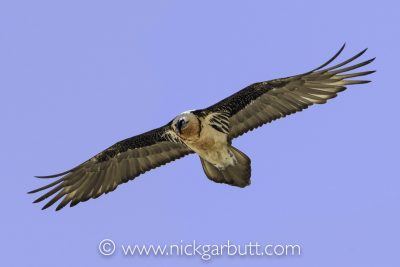
A magnificent adult lammergeier or bearded vulture
After a successful first venture to Ladakh in 2017 to look for snow leopards, I returned in March 2018 to spend a month in the mountains hoping to improve and expand up on my modest portfolio of images. The month was split very neatly into two halves: for the last two weeks of March, I was alone and free to set my own agenda very specifically to try and photograph the cats, then for the first half of April I would be joined by clients for a tour. To paraphrase sporting parlance, it was a game of two halves.
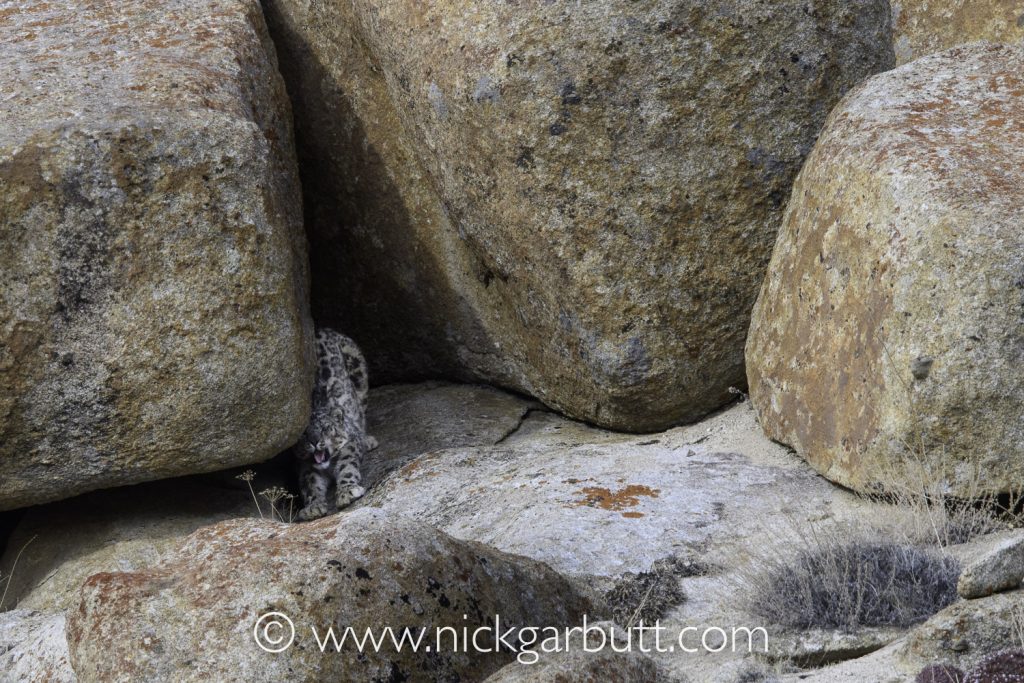
When she first emerged, the snow leopard stretched and yawned before walking out from beneath the boulder
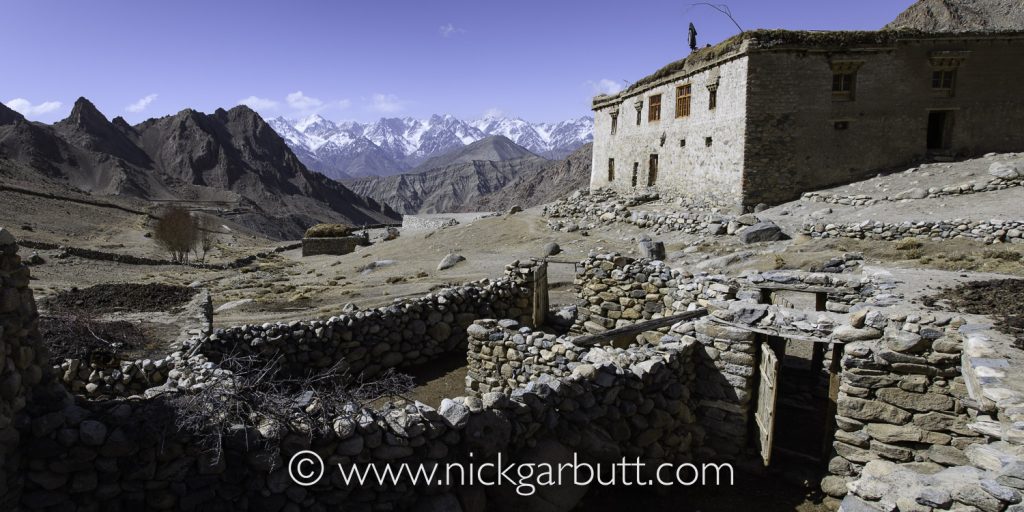
At the head of the valley, the home and corral where the snow leopard initially made the kill
Unlike 2017, when the valleys and mountains of the Ladakh Ranges were blanketed in thick snow, the landscape in March 2018 was parched brown and arid, revealing austere rocky slopes and rugged crags. It was almost devoid of snow, other than on the very tops of the mountains. In the particular valley I was based, this snowless state had apparently persisted all winter – barely a flake had fallen, and any brief flurry had quickly dissipated and melted. Not really the anticipated conditions in which to look for snow leopards.
Nonetheless, according to my local guides, snow leopard sightings in the area had remained good all winter. Of course, there had been quiet periods – lulls where sightings were infrequent and hard to come by, but most of the time, the cats were being seen.
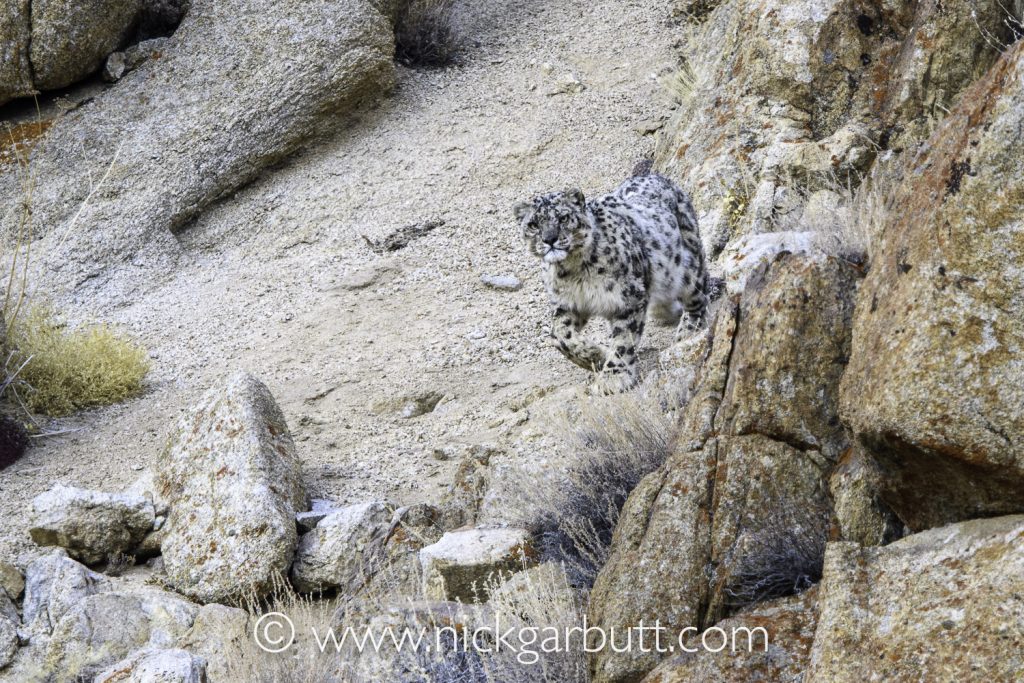
The female snow leopards' attention was drawn to the flock of magpies that had gathered on her kill
So I arrived at the lodge that would effectively be my home for a month, quietly confident of some success. During my initial foray in 2017, I had managed three meaningful snow leopard sightings in nine days, the final one yielding the best photos. But the closest I had managed to get to a cat was over 200m away and even with a 600mm lens, the subject remained rather small in the frame.

The female snow leopard bounds down steep rock face
Not long after I arrived, word filtered back that a snow leopard had made a kill higher up the valley. The cat had apparently broken into a corral during the night and taken a domestic yak (dzo): the carcass now lying some 200m away close a rocky outcrop, where the leopard was thought to be resting.
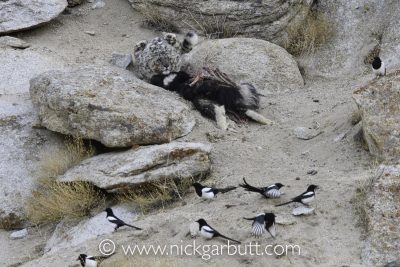
The female snow leopard guarding her kill from magpies
When I arrived at the scene, there were a handful of other people there, cameras at the ready - everyone keeping themselves tucked behind the walls and out buildings of the highest home in the valley, but all looking intently at an area of deep shade beneath a huge boulder half way up the slope. This was where the cat was resting I was told. The corpse of the dzo was clearly visible in an open patch of ground at the base of the rocky slope.
It was mid afternoon, sunny and still quite warm, so it seemed unlikely the cat would emerge until the evening. We all waited. I scanned the steep slopes of the surrounding mountains, just in case there was something else to see. High on the ridge a small group of ibex had gathered. It was hard to imagine what they might find to graze upon: any meager scrap of vegetation was surely shriveled and desiccated and contained all the nutritional value of a cardboard box.
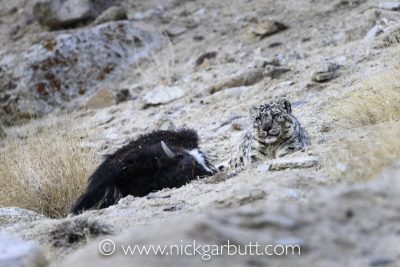
Most of the time when guarding her kill, female snow leopard was very relaxed
Around 5.30 in the afternoon the sun dipped below the western ridge of the valley and the rocky slope fell into shade. The temperature instantly plummeted. Was this the curtain call? Shortly afterwards there was discernable movement in the shadows and from beneath the right hand side of the huge boulder a spotted flank became visible. Then she (my guides told me it was a female) emerged, crouched, yawned and stretched and walked out to sit in front of the boulder. My heart raced as I composed the frame and fired the shutter in a first volley of shots.
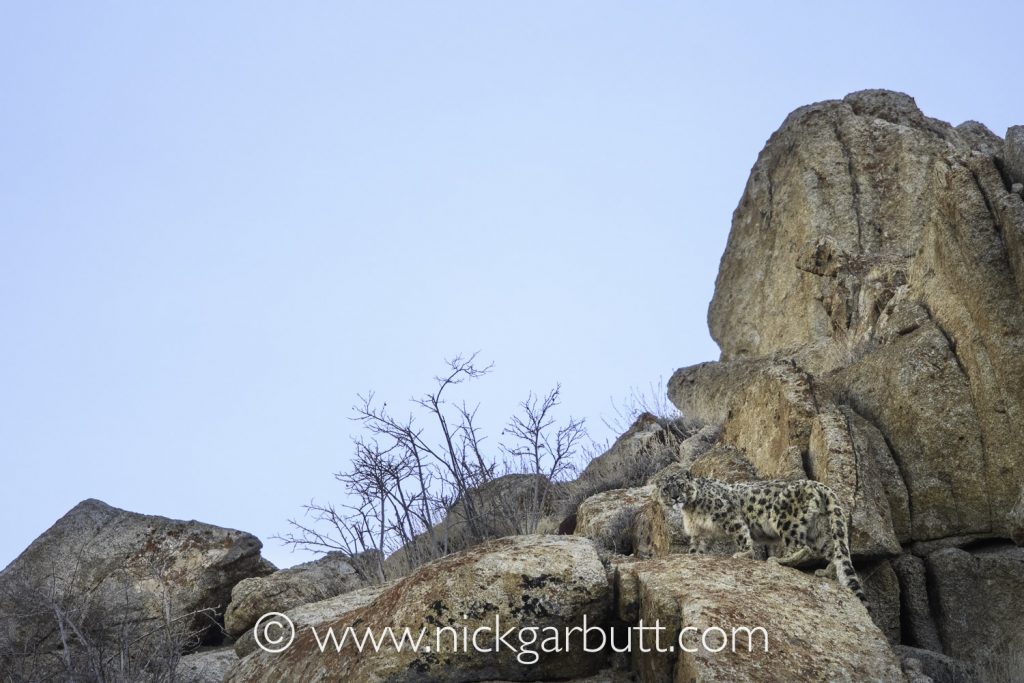
A snow leopard picks its way along a ridge top
The snow leopard nonchalantly surveyed the scene before her and appeared relaxed and unperturbed. An increasing number of noisy magpies gathered around the carcass and this drew her attention. She focused intently in their direction, her gaze fixed and unwavering. Without preamble or warning she sprung into action, stalking first across and then down the slope. Initially walking, her pace soon increased to a trot. Keeping up with her was difficult, her glorious grey and beige rosette coat providing exquisite camouflage. She picked her way between the boulders and bounded down rocky slopes like flowing molten mercury and in no time at all was at the base of the slope, now running towards the carcass and marauding magpies. The birds scattered in a piebald explosion of feathers as the cat reclaimed her prize. Then she settled and just sat next to the kill – just like the cat with the cream.

This snow leopard took advantage of the cool shade to lie low during the hotter times of day
For the next four mornings and evenings I was able to return, with the daily routine becoming familiar and predictable. At first light the snow leopard would still be sat on the carcass and feeding, but by 7.30am she had normally retreated back up the slope to the sanctuary of the rocks. Then late in the afternoon she would descend and continue to play the ongoing game of chase with the magpies. After four days there was barely a morsel of meat left and the nostril-tweaking aroma of death and decay filled the air. I knew on that fourth evening there was little chance she would still be there in the morning, so spent most of the time simply looking at her through my binoculars, still pinching myself I was so close to a wild snow leopard.
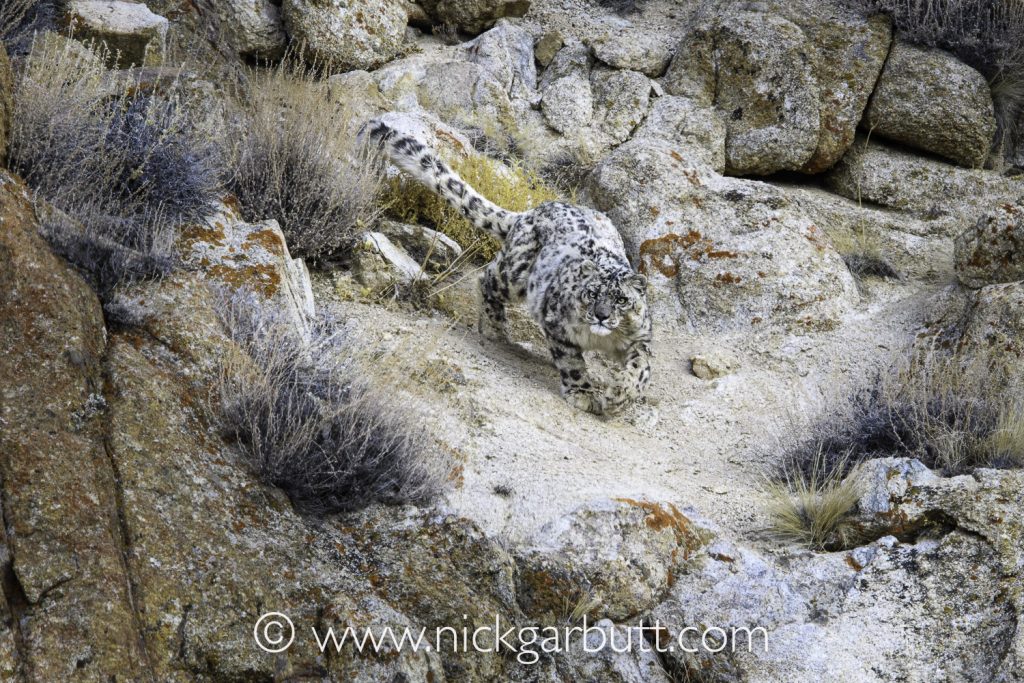
The sublime camouflage of a snow leopard is obvious when moving through broken rocky terrain
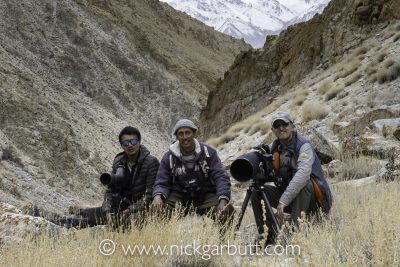
With two of my expert snow leopard guides, Stanzin (left) and Morup.
In the evening after that first afternoon, I’d eagerly downloaded my images and trawled through them picking out the best ones. There were certainly a dozen or more that stood out and were sufficiently different from one another. At the time it occurred to me that over the following month I may not get a better opportunity. Could I really have peaked and achieved the best images on day one? Well as it turned out the subsequent four days all provided further good opportunities and as each day progressed I was able to be more selective and try alternative angles. By the time the snow leopard had gone, I’d amassed a set of images that I could only have dreamt of beforehand.
Of course after she had gone, I continued to look for other snow leopards in the area. With my expert local guides we explored adjacent valleys and climbed numerous ridges over the next ten days. We found plenty of signs of snow leopard activity – pug marks, scat and the remains of kills – and we also managed to see three more cats, but all were at some distance and so offered limited opportunity for good photos.
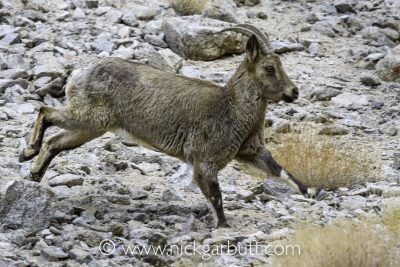
A female ibex runs across a rocky slope
So what of the second half? Having enjoyed a fabulous and productive time while on my own, I returned to the snow leopard area in early April with a group of clients, all full of expectation and eager to hopefully see snow leopards and the other wildlife of the Ladakh-Himalayan region.
Perhaps predictably, the Law of Sod played its hand. No sooner had we arrived at the lodge, than the weather took a turn for the worse, which means it turned un-seasonally warm and sunny – day in, day out. While looking for snow leopards, cold, snowy and overcast is better. When it is warm, the cats keep cool by lying low and staying in the shade. They hardly move around at all by day – all their activity is confined to the hours of darkness.
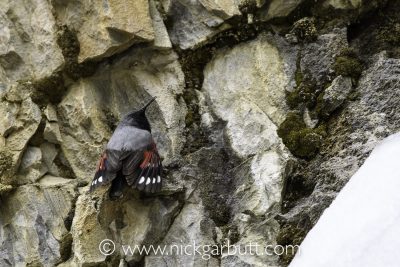
Male wallcreeper in breeding plummage
So frustratingly we struggled. Our guides searched high and low, far and wide and we certainly put in the time. Hour upon hour was spent scanning the steep slopes and rocky outcrops. Thankfully, on day five we succeeded and saw a snow leopard traverse across a scree slope on the east side of the valley, but it was rather distant and certainly not close enough for any meaningful photos.
We did see all the other expected wildlife of the region – ibex, urial (wild sheep), marmots, pika, wolves on two occasions and a good variety of birds, including excellent sightings of lammergeier, golden eagle and Himalayan snowcock, but for the remainder of our stay the main event eluded us.
There was no hiding the disappointment of both the clients and myself. Perhaps more than any of my other tours, ‘Searching for Snow Leopards’ puts ‘all eggs in one basket’ and there is scant comfort to be gained if sightings fail to live up to expectations.
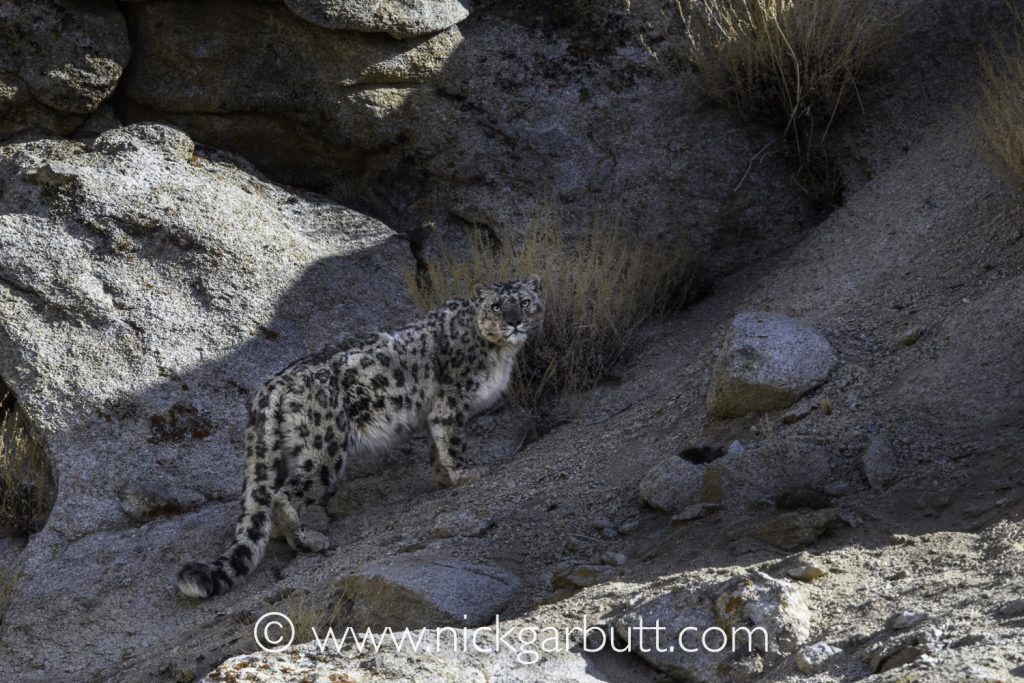
The incomparible stare of a snow leopard: a sighting like this makes all the effort worth while
Ultimately, our lack of success was simply down to really bad luck and the vagaries and fickle nature of wildlife watching. Perhaps more than another animal when it comes to looking for snow leopards, in order to achieve success, one needs to be fully prepared to embrace disappointment.
Nick Garbutt and Wildlife Worldwide will again be running snow leopard trips to Ladakh in 2019 and 2021.
Footnote:
Statistically the best months to look for snow leopards in the areas we visit are February, March and April, with little year-on-year variation between these months. In normal years, cold wintery weather persists until the end of April and even into May. Rather gallingly, there was another good sighting, between 21st and 23rd April, just two days after we had departed, when a different snow leopard had again killed a domestic yak near the village.
